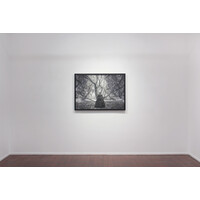Past Exhibitions
Exhibition Works
Lenticular Print Simulations
Exhibition Text
The person you are today is a different person to that which you were a day, a month, a decade ago. Time is relentless, and brings great changes. This is true not only of individuals, but also of places and cultures. All are changed by experience, by maturity, and by cross-pollination with other cultures.
Yuki Kihara continues her exploration of colonialism and post-colonialism with a series of lenticular photographs which depict the passage of time. The power of the lenticular image is in its duality. By showing two (or on this occasion, thanks to innovative techniques, three), alternating scenes we get a sense of life moving through a shifting landscape. Kihara uses her alter ego of Salome, dressed in Victorian costume, to indicate the ephemeral nature of life and the continuing parade of time. Salome is, in the artist's words, "a navigator of time who leaves traces of her presence [...] a lingering life-force that is felt in her absence. [This absence] can create a sense of longing or deeper appreciation for what is present." 1
It is not just the people who move and change. In Presence, Salome’s presence remains constant while the surrounding trees shift. The world rotates, the seasons change, and the world is different. We see changes in the light as morning turns through afternoon to evening, and the "sense of longing" for what was there before becomes a psychological negative space, shaping our attitude to the present.
The use of period costume brings the historical impact of colonialism to the fore. Salome becomes a portal to the gap between the worlds, neither here-and-now nor there-and-then, as she both experiences the colonial past and views it from outside. She is passing through vā, the space between worlds, where relationships between people and culture are built and understood. 2
The cross-cultural effect of colonialism is further embodied in the props depicted in the panoramic image Conveyance of Time. Here, traditional Polynesian navigation frames, the ava bowl, and the Holy Bible are brought together, creating conversation across cultures, and serving as symbols of navigation through physical, social, and spiritual worlds. Salome here is not one individual but an army, each with their own potential to move forward into a different future.
We have survived the past and embrace the present — but which way lies the journey from here?









